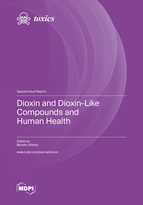Dioxin and Dioxin-Like Compounds and Human Health
A special issue of Toxics (ISSN 2305-6304). This special issue belongs to the section "Human Toxicology and Epidemiology".
Deadline for manuscript submissions: closed (15 November 2022) | Viewed by 23061
Special Issue Editor
Special Issue Information
Dear Colleagues,
In epidemiological studies, the associations of dioxin and dioxin-like (dl)-compound exposure with metabolic diseases including diabetes and metabolic syndrome in adults and with neurodevelopmental problems and earlier/later puberty in children have been suggested in the general population and environmentally exposed populations. Recently, the potential health effects of maternal dioxin and dl-compound exposure, such as infection and gut bacteria composition, have also been reported in children, suggesting various aspects of adverse health effects in the population exposed to dioxin and dl-compounds at wider range. Additionally, studies using molecular biomarkers such as RNA and DNA markers are aiming to clarify the health effects at molecular levels in the exposed population at high levels. Therefore, we are pleased to invite you to submit a paper to this Special Issue aiming to provide an overview of recent study results to investigate the effects of dioxin and dl compound exposure on human health from infants to adults in populations exposed to the various levels from background to historical pollution all over the world. Particularly, studies by advanced research methods, such as prospective longitudinal designs, intervention designs, meta-analyses, innovative technologies (MRI imaging analysis and eye-tracking), and molecular technics are very welcome to this Special Issue. Original research articles and reviews are welcome. We look forward to receiving your contributions.
Dr. Muneko Nishijo
Guest Editor
Manuscript Submission Information
Manuscripts should be submitted online at www.mdpi.com by registering and logging in to this website. Once you are registered, click here to go to the submission form. Manuscripts can be submitted until the deadline. All submissions that pass pre-check are peer-reviewed. Accepted papers will be published continuously in the journal (as soon as accepted) and will be listed together on the special issue website. Research articles, review articles as well as short communications are invited. For planned papers, a title and short abstract (about 100 words) can be sent to the Editorial Office for announcement on this website.
Submitted manuscripts should not have been published previously, nor be under consideration for publication elsewhere (except conference proceedings papers). All manuscripts are thoroughly refereed through a single-blind peer-review process. A guide for authors and other relevant information for submission of manuscripts is available on the Instructions for Authors page. Toxics is an international peer-reviewed open access monthly journal published by MDPI.
Please visit the Instructions for Authors page before submitting a manuscript. The Article Processing Charge (APC) for publication in this open access journal is 2600 CHF (Swiss Francs). Submitted papers should be well formatted and use good English. Authors may use MDPI's English editing service prior to publication or during author revisions.
Keywords
- dioxins
- dioxin-like compounds
- adverse health effects
- infants
- children
- adults
- general population
- environmental pollution







